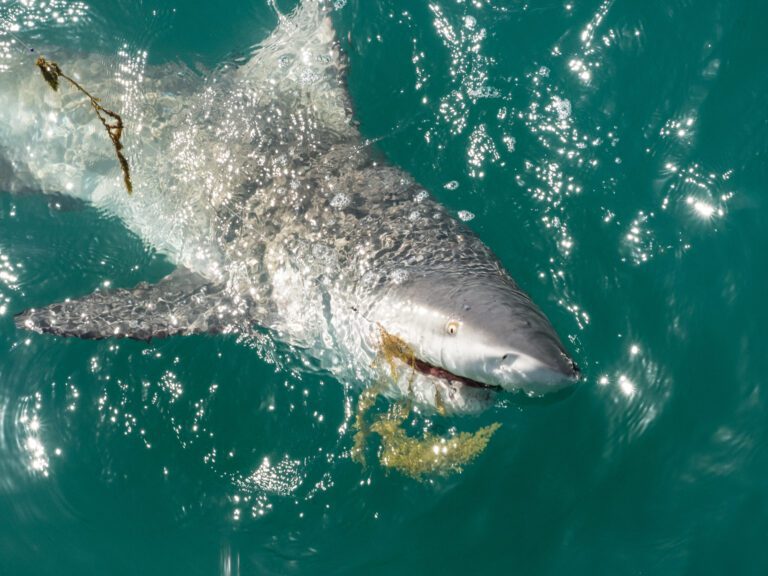Family Fishing Fun: A Simple Guide on How to Fish with Kids
Fishing with kids opens up a world of outdoor adventure, but where do you start? This ultimate guide zeroes in on how to fish with kids, ensuring a trip that’s easy, safe, and full of fun. With tips on the right gear for tiny hands, preparing for that first cast, and how to celebrate their catches, we lay the groundwork for a fishing journey that’s as rewarding for them as it will be for you. (check out the top 7 destinations in Florida to fish with your kids here)
Key Takeaways
- Get suitable fishing gear for kids with the right size and features, including character designs for toddlers and real, affordable options for older kids.
- Prep with a well-stocked tackle box and dress children appropriately for the weather, using UPF clothing and comfy, protective footwear.
- Introduce kids to fishing with patient instruction, practice casting on land first, and ensure you celebrate their catches and keep it fun with games and rewards.
Choosing the Right Gear for Your Young Angler

We all know that a musician is only as good as their instrument. The same goes for fishing. The right gear can make or break your child’s fishing experience. When selecting fishing poles for kids, it’s crucial to consider aspects such as:
- The rod’s length
- Weight
- Durability
- Comfort in your child’s hand
- Fun and cool design, maybe with their favorite color or character on it
Remember, we’re not just fishing for fun here; we’re fishing for enthusiasm. So, if you’re getting a spinning rod for a little kid, go for one that’s about three to four feet long. It’s a good balance of control and easy to use. For toddlers, the Zebco Dock Demon combos and the Zebco Slingshot Spincast Combo are excellent options. Tough and easy to handle, these spinning reels are perfect for little hands just getting into fishing.
For elementary-aged kids, models like the Zebco Roam are a good balance between quality and affordability.
Top Picks for Toddlers: Spincast Reels and Short Rods
If your little angler is a toddler, a spincast reel is your best friend. This reel style is perfect for your toddler’s first fishing trip as it’s super easy to use with a simple button that makes unwinding the line a breeze. Some of the best kids fishing poles for this age include the Zebco Roam, Shakespeare Disney Children’s Reel and Fishing Rod Combo, and Zebco Dock Demon Spincast Reel.
When choosing a rod, aim for one approximately three to four feet long. It’s a good balance between being easy to handle and working well. You also want to look for gear made from lightweight and tough materials like graphite, fiberglass, or composite blends. This makes the rod durable and easy for little hands to handle. Keep in mind, the objective is to ensure fishing remains an enjoyable activity, not a task!
Best Fishing Poles for Elementary-Aged Kids
As your little angler grows, so does their fishing gear. For elementary-aged kids, the Zebco Roam, Ugly Stik Dock Demon, and Shakespeare Disney Children’s Reel and Fishing Rod Combo are great choices. They’re tough, user-friendly, and designed to enhance the best kids fishing experience.
However, bear in mind that a quality fishing pole doesn’t have to be overly expensive. If you’re looking for a quality rod that’s not too pricey, the Zebco Roam is your best bet. It’s important to pick a ‘real’ fishing pole that’s light or ultra-light, and around five to six feet in length for the child’s growth. Well-known brands such as:
- Shakespeare
- Zebco
- 13 Fishing
- Wakeman
- Plusinno
All of these brands manufacture excellent fishing rods, including spinning rods that are ideally suited for elementary-aged children. Their kids fishing gear is designed with their needs in mind.
Advanced Options for Tweens and Teens
Now, if your young angler is a tween or a teen, it’s time to level up the game. At this age, they can handle a longer rod and a spinning reel. Shakespeare Ugly Stik Elite Spinning Combo or the Quantum Optix Spinning Reel and 2-Piece Fishing Rod Combo offer great value for the money, making them excellent reel combos.
A longer rod is great because it can cast farther and give better leverage when setting the hook. It might be a bit tough for some kids to handle at first, but after a little bit they will be happier than ever to see their casts flying through the air. Choosing the right reel style, like a spinning reel, can introduce them to “adult gear” and help them gain confidence in learning a new skill. Look for features like multiple external zip pockets and mesh pockets in their tackle system, which will make storing fishing accessories convenient for them.
Preparing for the First Fishing Trip
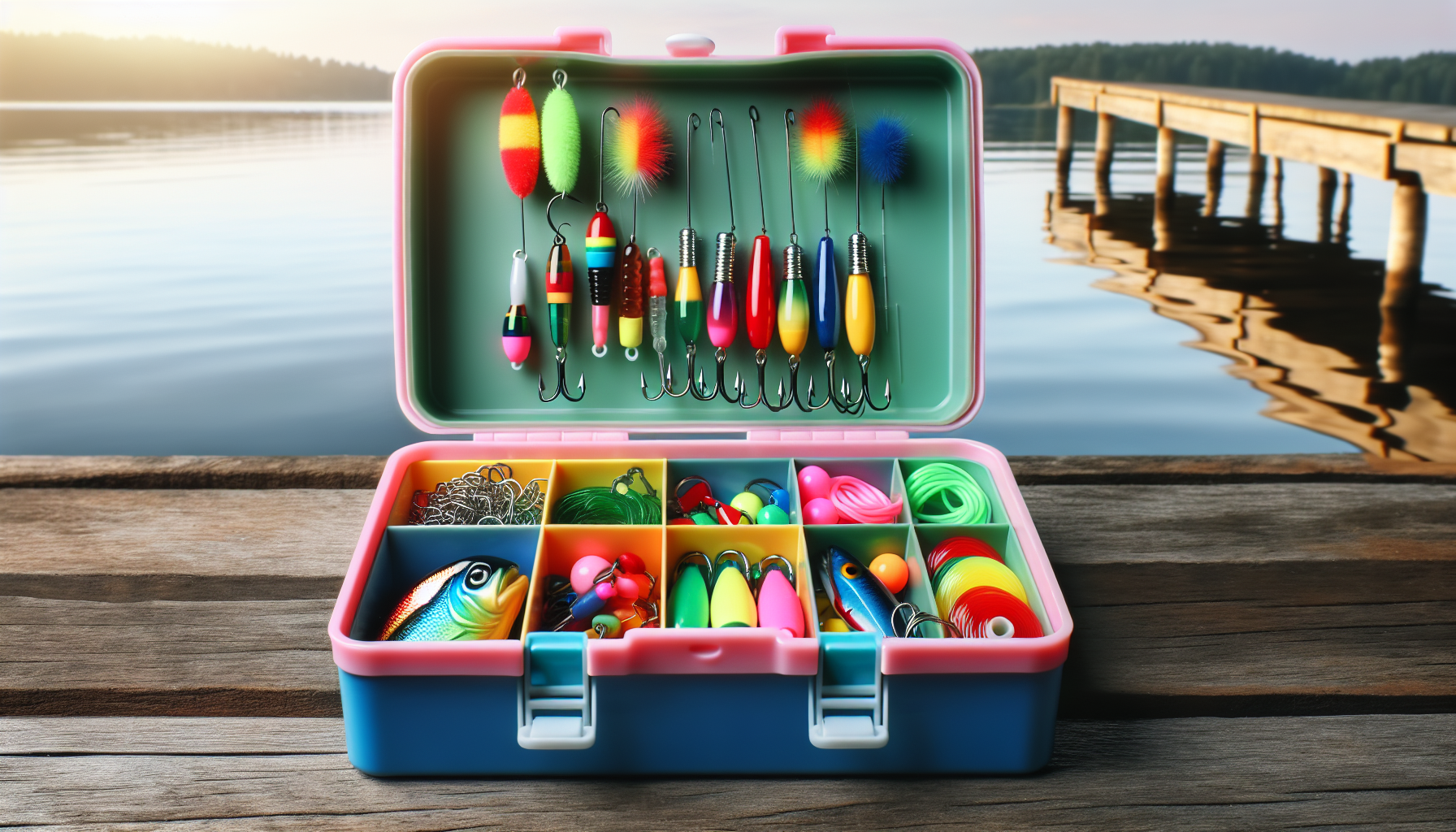
With the gear set up, it’s time to discuss preparations for the initial fishing trip. Apart from your child’s enthusiasm and your patience, two things are essential for a successful fishing trip: a well-stocked tackle box and appropriate clothing.
A tackle box is your magic chest of fishing. Having the right hooks, weights, and baits makes it easier and more fun for young anglers. As for clothing, comfort is key. Dress your child according to the weather, and don’t forget about UV sun protection. Brands like AFTCO and SIMMS have some awesome fishing apparel for kids, designed for comfort and UV sun protection.
Essential Tackle Box Checklist
So, what are the essentials to include in a child’s fishing tackle box? The basics include:
- Hooks
- Plastic worms
- Weights
- Spinner baits
- Topwater bait
- A variety of hook sizes and styles
Remember, the smaller EWG Bass hooks sizes 1/0 and 2/0, and just smaller hooks in general, are great for kids. They can catch smaller fish and handle bigger ones if they need to.
Also, don’t forget to bring:
- A fishing sinker: It helps the bait sink down to where the fish are hanging out by weighing down the hook and line.
- Extra fishing lines: Carry them in the tackle box in case the original line gets snagged, torn, or snapped.
- Live worms: They are a great option for bait as they attract fish and are fun for kids to handle. (if you are in freshwater)
- Live Greenbacks: They are a great option for saltwater fishing and less intimidating for young anglers compared to Pinfish or Shrimp.
Dressing Right for the Occasion
For clothing, prioritize comfort and safety. Here are some tips for different weather conditions:
- For sunny weather, opt for clothing made of UPF 50+ fabric.
- In hot and humid conditions, go for lightweight, breathable, and moisture-wicking materials.
- When fishing in cold climates, layer up! Polyester and spandex base layers, wool or fleece hats, thick wool socks, warm mittens, and a scarf for neck and face protection will keep your child cozy and warm.
Footwear is also important. Kids should wear comfortable and protective fishing or water shoes. Some great options are:
- Crocs
- Merrell
- Keen
- XTRATUF
Remember, fishing is fun, but it should also be safe. So, dress right for the occasion!
Teaching Kids How to Fish: Step by Step
With our gear organized and appropriate attire chosen, we can now dive into the exciting part: fishing! Teaching kids to fish is a step-by-step process, from casting techniques to handling fish. It’s a journey of learning, patience, and, most importantly, fun.
Initiate by demonstrating the correct way to hold the worm or fish and hook. Using soft artificial baits is a safer and easier option for them, especially in the beginning. Once they’ve become baiting experts, move on to casting. Practice makes perfect, so let them practice casting on land before you hit the water.
Casting Techniques for Little Hands
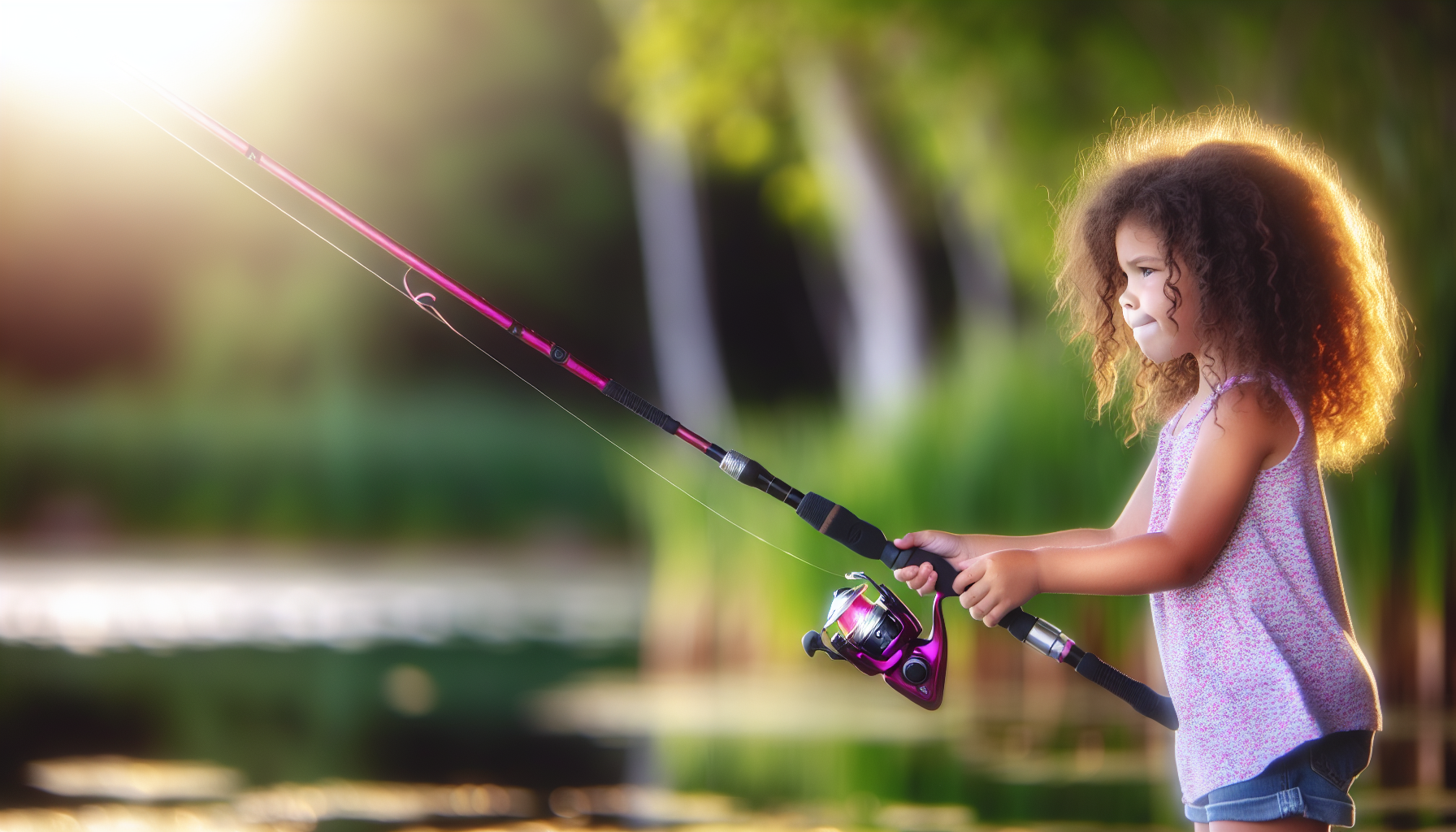
Casting is a skillful task, and successful execution heavily relies on technique, particularly for younger ones. Kids should copy how they hold and cast with their dominant hand, make sure not to hold the rod too tight, and use a grip that feels comfy and not too big. Frequently, kids may mess up casting by using too much line, starting with the wrong foot, or doing too much false casting. Helping them understand these issues and how to fix them will improve their casting skills. And remember, gear like the Kid Casters Youth fishing kit, which comes with an all-in-one rod and reel and practice casting plugs, can make learning to cast easier for them.
Hook, Line, and Sinker: Baiting Tips
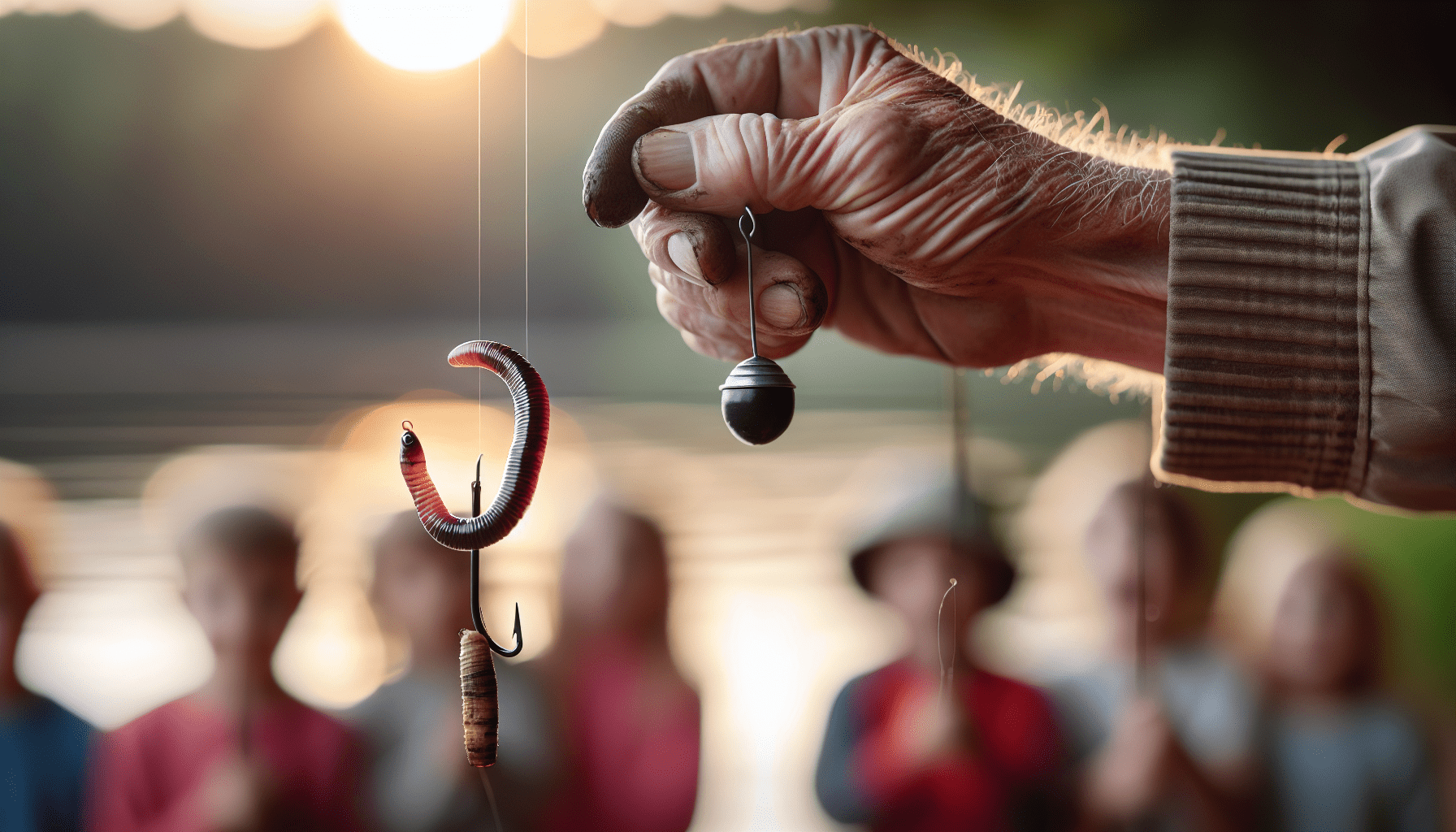
Baiting is a crucial part of fishing. To bait a hook safely and effectively, use barbless hooks. They’re easier to remove if someone gets snagged. You can also de-barb the hooks by squeezing down the barb with pliers, which makes them safer for kids to handle.
As for the baits, live worms and greenbacks work great. They attract fish and are fun for kids to handle. When it comes to sinkers, setting up a simple rig with a running sinker, a plastic bead, and a small bait keeper hook is a good trick. This setup makes the weight at the end of the line, making it easier for kids to cast.
Celebrating the Catch: Handling Fish with Care
The awaited moment is here. Your child has reeled in their first fish, signaling a cause for celebration! But remember, we need to treat our finned friends with care. When your child catches a fish, make sure you’re in a safe spot and have all your gear ready. Safety is the most important thing, so be super clear about the steps and keep it all safe.
When it’s time to release the fish, follow these steps:
- Hold it gently with one hand under its belly and the other hand on its bottom.
- Let it go facing the current if you can.
- If it’s freaking out, holding it upside down can help calm it down before you release it.
Be sure to commemorate this significant event with plenty of hugs, high fives, and naturally, photographs!
Making Fishing Fun for Kids
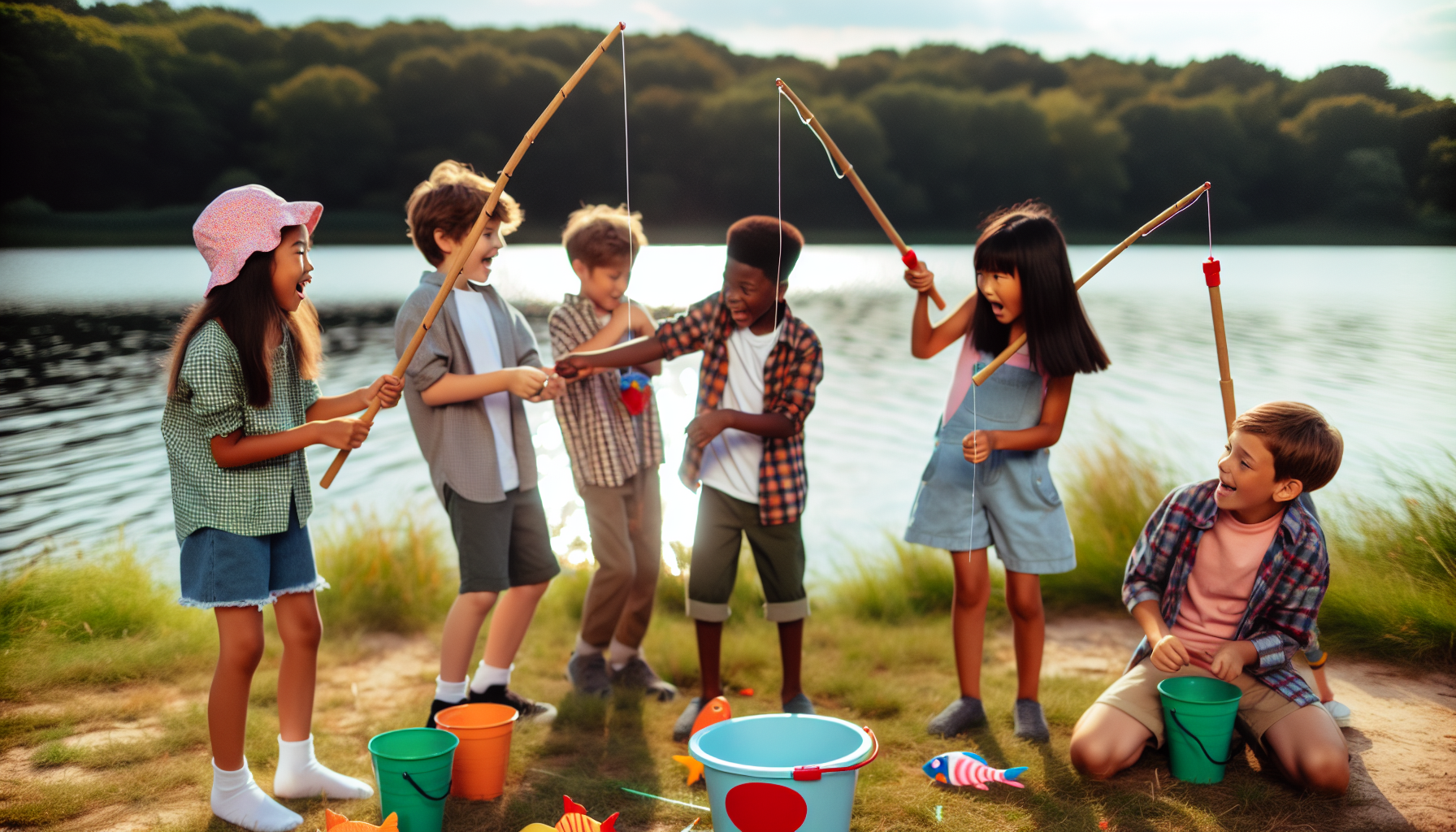
While fishing is already a fun-filled activity, it’s necessary to infuse an additional element of enjoyment to maintain children’s engagement. Here are some ways to make fishing more enjoyable for your young anglers:
- Play fishing games
- Offer rewards for catching fish
- Create a friendly competition
- Bring snacks and drinks
- Take breaks for other activities, like swimming or exploring
By incorporating these ideas, you can ensure that your children have a great time while fishing.
Remember, the goal is not just to catch fish but to make lasting memories. So, bring along toys, coloring books, digging tools, and a children’s fishing book. Trying different styles like fishing camping or night fishing can bring a new level of excitement to the experience.
Games and Challenges
Incorporating games and challenges can transform fishing into a thrilling expedition for kids. You can introduce games like ‘Fishing for Candy Canes’, ‘Aluminum Foil Fish’, or ‘Fishing for the Words’. These games not only provide entertainment but also help with coordination, eye-hand movement, and motor skills.
Parents can also create their own fishing games. Try fishing for words, making aluminum foil fish, or using pool noodles and googly eyes. The possibilities are endless! And if you don’t feel like creating your own games, there are many commercial fishing games available, like Let’s Go Fishin’ Game by Pressman, TOP BRIGHT Montessori Toddler Fishing Game, and Gone Fishin Game.
Rewards and Recognition
Children are greatly motivated by rewards and recognition. Setting up a reward system like filling a treasure chest with coins and offering special rewards based on what the child likes can keep them excited about fishing.
You can also use behavior charts where kids can earn stars or coins for good behavior and exchange them for rewards they want. Remember to celebrate their milestones, whether it’s their first cast, first fish, or a new personal best. A little recognition can go a long way in boosting their confidence and love for fishing.
Safety First: Ensuring a Secure Fishing Experience
While fishing is a delightful activity, safety must always be the primary concern. From water safety to first aid, it’s important to equip yourself with the necessary knowledge and tools to ensure a secure fishing experience for your kids.
Ensure your child’s safety near water by following these guidelines:
- Always have your child wear a life jacket when in proximity to water.
- Keep a close eye on them, even if they’re wearing a life jacket.
- Remember to pack a first aid kit for those unexpected scrapes and scratches.
Water Safety Essentials
In terms of water safety, wearing a life jacket is non-negotiable. It not only keeps your child safe from drowning but provides extra float if they accidentally fall into the water. Brands like the Spinner Youth and The Classic by Bluestorm offer life jackets that are snug and secure, ensuring your child’s safety.
Remember, even with a life jacket on, an adult should always supervise kids near water. So, keep an eye on your little anglers at all times to ensure they’re safe. Particularly in Florida, where Alligators are present in many freshwater environments.
First Aid Preparedness
Having a first aid kit is imperative for every fishing excursion. It should include:
- Bandages
- Antiseptic wipes
- Antibiotic cream
- Painkillers
- Eye wash
- Burn cream
- Cotton swabs or pads
- A first aid guide
Also, it’s important to know how to handle common fishing-related injuries, like fish hook injuries. Here are the steps to follow:
- Numb the area with ice or cold water.
- If the barb isn’t in the skin, carefully pull the hook back.
- Apply pressure to stop the bleeding.
- Wash your hands.
- If you can, remove the hook and clean the wound thoroughly to avoid infection.
- Head to the emergency room to ensure there is no further infection like tetanis.
Adapting to Different Fishing Environments
Fishing isn’t confined to one location. There’s a whole world of fishing spots to explore, including a fishing adventure in various:
- Lakes
- Rivers
- Streams
- Ponds
Each environment offers a unique experience and requires different techniques. So, let’s dive into how to adapt to different fishing environments.
When fishing in a lake, concentrate on the children, aim for fish that are easy to catch, maintain simplicity with the gear, and avoid lingering for an overly extended period. For river and stream fishing, it’s about handling moving water, practicing casting in flowing water, and adapting techniques for the current. If you are fishing in the ocean, enjoy the day at the beach or pier and keep your eyes peeled for any Dolphins or Manatees that could be near by.
Lake Fishing with Kids
Lake fishing is a great starting point for young anglers. It offers a stable environment with calm water, which allows kids to focus on finding the best spots to fish. When choosing a lake for fishing, consider factors like the types of water and fish in the lake. Some lakes that offer great fishing experiences for kids include:
- Lake Michigan
- Pewaukee Lake
- Geneva Lake
- Delavan Lake
- Big Bear Lake
- Castaic Lake
- Drake Lake
The best time to go fishing at the lake with kids is early in the morning or later in the evening. That’s when the fish are more active and the water is cooler. And remember to practice casting on land before you hit the water. This helps kids get a feel for the rod and reel and increases their chances of a successful catch.
River and Stream Adventures
Fishing in rivers and streams introduces an entirely new dimension of excitement. The moving water adds a bit of a challenge but also offers a rewarding experience. It’s all about adapting to the current and practicing casting in flowing water.
Kids can catch a variety of fish in rivers and streams, including panfish and trout. To catch fish in rivers and streams, follow these tips:
- Let your bait float down the river current and wait for a strike.
- Hold your rod tip higher to keep the line out of the flow of the current.
- Using a slip bobber rig can help you catch fish in deeper water.
Summary
Fishing with kids is about more than just catching fish. It’s about spending quality time together, creating lasting memories, and fostering a love for nature. From choosing the right gear to teaching them how to fish and ensuring their safety, every step is a learning experience. So, the next time you’re planning a family outing, why not take them fishing? You’ll be hooking not just fish, but also beautiful memories.
Frequently Asked Questions
How do you fish with little kids?
Make fishing fun and easy for your kids by giving them simple equipment, choosing a smaller pond, using live bait, limiting your time on the water, and focusing on fun. Remember to involve your child in the fishing process to keep them engaged.
What is the best age to start fishing with kids?
The best age to start fishing with kids is between 2 to 4, when they have decent control of their bodies and movements, and can communicate fairly well. So, grab those fishing poles and head out for a great family adventure!
How do you entertain kids while fishing?
To entertain kids while fishing, you can involve them in activities like playing with worms, launching leaf “boats” into the water, or taking a break for a walk. It’s best to keep the first fishing trip short, around an hour or two, to keep the kids engaged.
Can little kids go fishing?
Yes, little kids can go fishing with the assistance and guidance of their guardian, parents, grandparents or a trusted family member. So, it’s a great way for them to learn and have fun outdoors!
What type of reel is best for kids?
The best type of reel for kids is a closed-faced freshwater spincast reel, which has a simple push-button design that is easier for young anglers to use. The majority of spincast fishing rod and reel combos come pre-spooled with 6-pound-test line.




